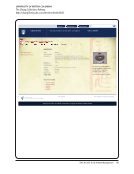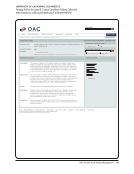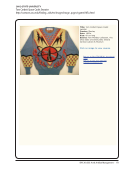116 · Representative Documents: Arrangement Guidelines
Washington University in St. Louis
Modern Graphic History Library Processing Manual
6
Description
The process of establishing intellectual and administrative control over holdings through the preparation
of finding aids.
Objectives of Description
• To provide administrative control for the repository staff
o Location of collections physically, so it can be located
o General contents of collections
o Provenance of collections (Why is it here? How long has it been here?)
• To establish intellectual control for the researcher
o General nature of repository's holdings
o General contents of individual collections
o Information available on a specific topic
o Specific information available within an individual collection
Levels of Description (from general to more specific)
• Repository (Online list of finding aids in University Archives for staff and patrons shelf list for
staff).
• Collection (Finding Aid, Inventory, Box List, etc.).
• Series and subseries (located within a finding aid).
• Folder (located within a finding aid).
• Document (inventory of individual items located in folders).
o Normally used only for very small or very important collections.
Qualities of Good Finding Aids
• Clarity and conciseness
• Anticipation of researchers' needs
• Objectivity
• Avoid archival jargon (provenance, ephemera, etc.)
• Avoid terminology that may be confusing or archaic.
• Avoid abbreviations or acronyms when possible (except for very well known, YMCA, US)
Washington University in St. Louis
Modern Graphic History Library Processing Manual
6
Description
The process of establishing intellectual and administrative control over holdings through the preparation
of finding aids.
Objectives of Description
• To provide administrative control for the repository staff
o Location of collections physically, so it can be located
o General contents of collections
o Provenance of collections (Why is it here? How long has it been here?)
• To establish intellectual control for the researcher
o General nature of repository's holdings
o General contents of individual collections
o Information available on a specific topic
o Specific information available within an individual collection
Levels of Description (from general to more specific)
• Repository (Online list of finding aids in University Archives for staff and patrons shelf list for
staff).
• Collection (Finding Aid, Inventory, Box List, etc.).
• Series and subseries (located within a finding aid).
• Folder (located within a finding aid).
• Document (inventory of individual items located in folders).
o Normally used only for very small or very important collections.
Qualities of Good Finding Aids
• Clarity and conciseness
• Anticipation of researchers' needs
• Objectivity
• Avoid archival jargon (provenance, ephemera, etc.)
• Avoid terminology that may be confusing or archaic.
• Avoid abbreviations or acronyms when possible (except for very well known, YMCA, US)


















































































































































































